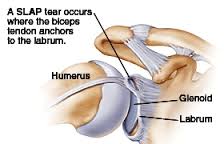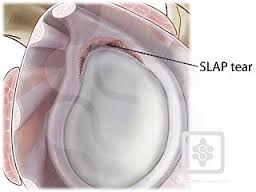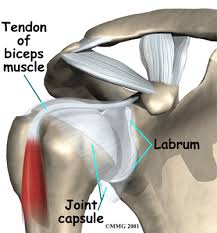SLAP Lesion: Difference between revisions
No edit summary |
No edit summary |
||
| Line 9: | Line 9: | ||
[[Image:SLAP1.jpg]][[Image:SLAP2.jpg]] | [[Image:SLAP1.jpg]][[Image:SLAP2.jpg]] | ||
A SLAP tear or lesion occurs when there is damage to the superior (uppermost) area of the labrum. These lesions have come into public awareness because of their frequency in athletes involved in overhead and throwing activities in turn relating to relatively recent description of labral injuries in throwing athletes,[1] and initial definitions of the 4 (major) SLAP sub-types,[2] all happening since the 1990s. The identification and treatment of these injuries continues to evolve. | |||
== Mechanism of Injury / Pathological Process<br> == | == Mechanism of Injury / Pathological Process<br> == | ||
[[Image:Labrum1.jpg]]<br> | |||
A SLAP Tear occurs if you get the tear at the end of The Biceps where it attaches to the Glenoid via the Labrum as shown in the above image. At the end of biceps attaches to the labrum which attaches to the glenoid. It serves as the anchor for biceps muscle, so it is very important for lifting things from the ground. Imagine a weight pulling down on your arm and rotatorcuff, biceps, and all other shoulder stabilizer muscles resisting that force and contracting to keep your arm from being pulled down. | |||
They are like traction injuries where the arm is pulled suddenly from the socket. | |||
== Symptoms == | |||
Several symptoms are common but not specific:[3] | |||
Dull, throbbing, ache in the joint which can be brought on by very strenuous exertion or simple household chores.<br>Difficulty sleeping due to shoulder discomfort. The SLAP lesion decreases the stability of the joint which, when combined with lying in bed, causes the shoulder to drop.<br>For an athlete involved in a throwing sport such as baseball, pain and a catching feeling are prevalent. Throwing athletes may also complain of a loss of strength or significant decreased velocity in throwing.<br>Any applied force overhead or pushing directly into the shoulder can result in impingement and catching sensations.<br> | |||
== Diagnostic Procedures == | == Diagnostic Procedures == | ||
Besides MRI, a through subjective and objective examination by a Physical therapist is important in identifying the likelyhood of a labral tear.<br> | |||
Investigations such as Ultrasound may help to exclude the presence of other injuries in shoulder. | |||
Sometimes an MRI with contrast is recommended to see if there is a tear. | |||
== | == SubTypes == | ||
Although ten varieties of SLAP lesion have been described on MRI or MR arthrography[4] seven clinical types are generally described.[5] | |||
Type I. Degenerative fraying of the superior portion of the labrum, with the labrum remaining firmly attached to the glenoid rim<br>Type II. Separation of the superior portion of the glenoid labrum and tendon of the biceps brachii muscle from the glenoid rim<br>Type III. Bucket-handle tears of the superior portion of the labrum without involvement of the biceps brachii (long head) attachment<br>Type IV. Bucket-handle tears of the superior portion of the labrum extending into the biceps tendon<br>Type V. Anteroinferior Bankart lesion that extends upward to include a separation of the biceps tendon<br>Type VI. Unstable radial flap tears associated with separation of the biceps anchor<br>Type VII. Anterior extension of the SLAP lesion beneath the middle glenohumeral ligament | |||
== Management / Interventions<br> == | == Management / Interventions<br> == | ||
Non Physiotherpy Treatment<br> | |||
== Differential Diagnosis<br> == | == Differential Diagnosis<br> == | ||
| Line 40: | Line 54: | ||
== Resources <br> == | == Resources <br> == | ||
* 1) Andrews, JR; Carson WG, Jr; McLeod, WD (Sep–Oct 1985). "Glenoid labrum tears related to the long head of the biceps.". The American journal of sports medicine. 13 (5): 337–41. doi:10.1177/036354658501300508. PMID 4051091.<br>* 2) Jump up ^ Snyder, SJ; Karzel, RP; Del Pizzo, W; Ferkel, RD; Friedman, MJ (1990). "SLAP lesions of the shoulder.". Arthroscopy. 6 (4): 274–9. PMID 2264894. | |||
* 3) Chang D, Mohana-Borges A, Borso M, Chung CB (Oct 2008). "SLAP lesions: anatomy, clinical presentation, MR imaging diagnosis and characterization". Eur J Radiol. 68 (1): 72–87. doi:10.1016/j.ejrad.2008.02.026. PMID 18499376. | |||
* 4) Mohana-Borges AV, Chung CB, Resnick D (December 2003). "Superior labral anteroposterior tear: classification and diagnosis on MRI and MR arthrography". AJR Am J Roentgenol. 181 (6): 1449–62. doi:10.2214/ajr.181.6.1811449. PMID 14627555. | |||
* 5) Aydin N, Sirin E, Arya A (Jul 18, 2014). "Superior labrum anterior to posterior lesions of the shoulder: Diagnosis and arthroscopic management". World J Orthop. 5 (3): 344–50. doi:10.5312/wjo.v5.i3.344. PMID 25035838. | |||
== Case Studies == | == Case Studies == | ||
Revision as of 10:25, 8 December 2016
Original Editor - Venugopal Pawar
Lead Editors
Clinically Relevant Anatomy
[edit | edit source]
A SLAP tear or SLAP lesion is an injury to the glenoid labrum (fibrocartilaginous rim attached around the margin of the glenoid cavity). SLAP is an acronym for "superior labral tear from anterior to posterior".
A SLAP tear or lesion occurs when there is damage to the superior (uppermost) area of the labrum. These lesions have come into public awareness because of their frequency in athletes involved in overhead and throwing activities in turn relating to relatively recent description of labral injuries in throwing athletes,[1] and initial definitions of the 4 (major) SLAP sub-types,[2] all happening since the 1990s. The identification and treatment of these injuries continues to evolve.
Mechanism of Injury / Pathological Process
[edit | edit source]
A SLAP Tear occurs if you get the tear at the end of The Biceps where it attaches to the Glenoid via the Labrum as shown in the above image. At the end of biceps attaches to the labrum which attaches to the glenoid. It serves as the anchor for biceps muscle, so it is very important for lifting things from the ground. Imagine a weight pulling down on your arm and rotatorcuff, biceps, and all other shoulder stabilizer muscles resisting that force and contracting to keep your arm from being pulled down.
They are like traction injuries where the arm is pulled suddenly from the socket.
Symptoms[edit | edit source]
Several symptoms are common but not specific:[3]
Dull, throbbing, ache in the joint which can be brought on by very strenuous exertion or simple household chores.
Difficulty sleeping due to shoulder discomfort. The SLAP lesion decreases the stability of the joint which, when combined with lying in bed, causes the shoulder to drop.
For an athlete involved in a throwing sport such as baseball, pain and a catching feeling are prevalent. Throwing athletes may also complain of a loss of strength or significant decreased velocity in throwing.
Any applied force overhead or pushing directly into the shoulder can result in impingement and catching sensations.
Diagnostic Procedures[edit | edit source]
Besides MRI, a through subjective and objective examination by a Physical therapist is important in identifying the likelyhood of a labral tear.
Investigations such as Ultrasound may help to exclude the presence of other injuries in shoulder.
Sometimes an MRI with contrast is recommended to see if there is a tear.
SubTypes[edit | edit source]
Although ten varieties of SLAP lesion have been described on MRI or MR arthrography[4] seven clinical types are generally described.[5]
Type I. Degenerative fraying of the superior portion of the labrum, with the labrum remaining firmly attached to the glenoid rim
Type II. Separation of the superior portion of the glenoid labrum and tendon of the biceps brachii muscle from the glenoid rim
Type III. Bucket-handle tears of the superior portion of the labrum without involvement of the biceps brachii (long head) attachment
Type IV. Bucket-handle tears of the superior portion of the labrum extending into the biceps tendon
Type V. Anteroinferior Bankart lesion that extends upward to include a separation of the biceps tendon
Type VI. Unstable radial flap tears associated with separation of the biceps anchor
Type VII. Anterior extension of the SLAP lesion beneath the middle glenohumeral ligament
Management / Interventions
[edit | edit source]
Non Physiotherpy Treatment
Differential Diagnosis
[edit | edit source]
add text here relating to the differential diagnosis of this condition
Key Evidence[edit | edit source]
add text here relating to key evidence with regards to any of the above headings
Resources
[edit | edit source]
- 1) Andrews, JR; Carson WG, Jr; McLeod, WD (Sep–Oct 1985). "Glenoid labrum tears related to the long head of the biceps.". The American journal of sports medicine. 13 (5): 337–41. doi:10.1177/036354658501300508. PMID 4051091.
* 2) Jump up ^ Snyder, SJ; Karzel, RP; Del Pizzo, W; Ferkel, RD; Friedman, MJ (1990). "SLAP lesions of the shoulder.". Arthroscopy. 6 (4): 274–9. PMID 2264894.
- 3) Chang D, Mohana-Borges A, Borso M, Chung CB (Oct 2008). "SLAP lesions: anatomy, clinical presentation, MR imaging diagnosis and characterization". Eur J Radiol. 68 (1): 72–87. doi:10.1016/j.ejrad.2008.02.026. PMID 18499376.
- 4) Mohana-Borges AV, Chung CB, Resnick D (December 2003). "Superior labral anteroposterior tear: classification and diagnosis on MRI and MR arthrography". AJR Am J Roentgenol. 181 (6): 1449–62. doi:10.2214/ajr.181.6.1811449. PMID 14627555.
- 5) Aydin N, Sirin E, Arya A (Jul 18, 2014). "Superior labrum anterior to posterior lesions of the shoulder: Diagnosis and arthroscopic management". World J Orthop. 5 (3): 344–50. doi:10.5312/wjo.v5.i3.344. PMID 25035838.
Case Studies[edit | edit source]
add links to case studies here (case studies should be added on new pages using the case study template)
Recent Related Research (from Pubmed)[edit | edit source]
Extension:RSS -- Error: Not a valid URL: Feed goes here!!|charset=UTF-8|short|max=10
References[edit | edit source]
References will automatically be added here, see adding references tutorial.









